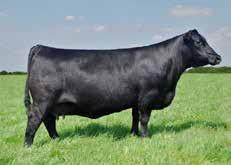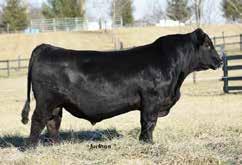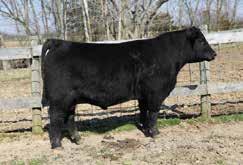
10 minute read
Darrh Bullock: Let It Rain! What Does The Weather Have To Do With Genetics?
Let It Rain! What Does The Weather Have To Do With Genetics?
Darrh Bullock University of Kentucky Beef Specialist Changes to the 2022 CAIP Beef Genetic Improvement Program
As I am writing this article it is raining in the Bluegrass. Again! Please do not get me wrong, I am not complaining; I would rather have too much than too little when it comes to rain. Based on data from the National Integrated Drought Information System, we have not had a serious drought in Kentucky since 2012 and only two relatively dry periods since then. Based on my unscientific interpretation of the historical data this is the longest period of favorable rainfall we have had in the state since 1900 and that is as far back as I went. From a geneticist perspective, what concerns me is that I am afraid we are getting spoiled. My fear is that this is not the new normal and soon we are going to have to deal with cyclical droughts again. The reason this concerns me is that we need to target our genetics program to fit both the market we are selling into and the environment we are subjecting our cattle to. Under the forage growing conditions we have been exposed to the last 10 years most operations could sustain larger, heavier milking cows than their management could support under normal conditions. This has coincided with a national genetic trend of increased size and increased milking ability of many of the popular breeds. The result of increased production genetics in combination with abundant forages has been overall increased beef production in many herds. So, what’s the problem? We need to remember that total production of the herd is a factor of both reproduction and pounds of salable product. Increases in genetics for growth and milking ability lead to heavier calves and more pounds to sell. This is great as long as we can maintain reproduction and under the current, and near past, forage conditions this has not been a problem for most. However, we have been altering our cowherd’s genetics that has increased their requirements for both maintenance and production energy, even though that may not have been our intentions. This may become a serious issue when we get back into periods of limited forage production due to droughts. The problem is that reproduction is greatly affected by the energy requirements of the cow and available nutrients. The higher the productivity of the cow (weight and milking ability) the greater her needs are for energy to stay reproductive. So, your cows that have stayed reproductive during these good times may have difficulty rebreeding when exposed to nutritional stress brought on by a drought. I am not promoting a doomsday approach to your breeding program; I am just reminding you that you need to consider the level of production that your herd can sustain during normal conditions so that you aren’t caught off guard. A couple of years of poor reproduction can undo several years of increased production from an economic standpoint in most herds. What is the solution? The good news is that there are ways to position yourself to take advantage of the good times while limiting the negative impacts of the bad times. The most important practice you can implement in a commercial beef operation is a good crossbreeding program. The benefit of crossbreeding is referred to as heterosis and we get an increased benefit from heterosis under harsh conditions. Another plus is that one of the traits that is impacted the most from crossbreeding is increased reproductive performance. From a selection standpoint it is advisable to use Expected Progeny Differences (EPD) to identify bulls that fit your market and management, while considering the impact of extremes in environmental conditions. For most of us this is to avoid the lure of “more is better” and think of what is optimum for your conditions. If we do these things then we can avoid disastrous situations, most of the time, but when we are faced with nutritional challenges then we need to consider supplementing to get us through the hard times. Monitor the body condition of your cows going into calving through breeding and make sure you have them in good flesh. If they start getting thin, then provide them with additional nutrition to avoid a reproductive disaster. If this happens often, then your genetics for production are probably too high for the forage management you are providing and one or both should be adjusted. At the beginning of every year, the guidelines for the CAIP Genetic Improvement Program are updated. These changes include adjusting the EPD requirements for any breed that has had a change to their genetic evaluation or any other changes that the Kentucky Agriculture Development Board’s Program Evaluation Committee decide to implement (pending final board approval). This year there were minimal changes to the EPD guidelines with Charolais being the only breed to have changes in their EPD values because of changes to their genetic evaluation. Also, Red Angus was included in the Alternative - Selection Index for the Balanced Trait category. Last year bulls were required to have Genomically Enhanced EPDs, which will continue, but an alternative is that the bull can have an Accuracy value for Calving Ease Direct of .25 or greater (this was lowered by the committee from .30). One last change is there is no longer an upper limit to Weaning Weight for a balanced trait bull (however, the upper limit for Yearly Weight remains). For all of the guidelines for the bull costshare program go to: https://www.kyagr. com/agpolicy/2022-Program-Guidelines-and-Applications.html. To get the latest updates to the EPD guidelines please go to: https://afs.ca.uky.edu/beef/ publications/breeding-management and click on the “Beef Sire Selection for Cattle Genetic Improvement Program - CAIP EPD Guidelines for Bulls” link. The KY Bull Assessment Tool (https:// afs.ca.uky.edu/beef/KBAT) can assist you in determining if a bull qualifies for cost-share.
Spring Calving Herds
• Watch cows and calves closely. Work hard to save every calf (you can cull/sell them later). Calves can be identified while they are young and easy to handle. Commercial male calves should be castrated and implanted. Registered calves should be weighed at birth. • Cows that have calved need to be on an adequate nutritional level to rebreed. Increase their feed after calving. Don’t let them lose body condition. Keep feeding them until pastures are adequate. • Don’t “rush to grass” although it can be really tempting. Be sure that grass has accumulated enough growth to support the cow’s nutritional needs before depending solely upon it. Cows may walk the pastures looking for green grass instead of eating dry feed. This lush, watery grass is not adequate to support them. Keep them consuming dry feed until sufficient grass is available to sustain body condition.
We’ve spent too much money keeping them in good condition to lose it now! • Prevent grass tetany! Provide magnesium in the mineral mix until daytime temperatures are consistently above 60oF. Mineral supplement should be available at all times and contain a minimum of about 14 percent magnesium. Make sure that your mineral mix also contains adequate selenium, copper and zinc. You can ask your feed dealer about the UK Beef IRM High Magnesium Mineral. • Make final selection of heifer replacements. Strongly consider vaccinating with a modified-live BVD vaccine. • Purchase replacement bulls at least 30 days prior to the start of the breeding season. Have herd bulls evaluated for breeding soundness (10-20% of bulls are questionable or unsatisfactory breeders). Get all bulls in proper condition (BCS 6) for breeding. • If you are going to use artificial insemination and/or estrous synchronization, make plans now and order needed supplies, semen, and schedule a technician. • Prebreeding or "turn out" working is usually scheduled for late April or May between the end of calving season and before the start of the breeding season (while cows are open). Consult your veterinarian about vaccines and health products your herd needs. Make arrangements now for products needed and have handling facilities in good working order. Dehorn commercial calves before going to pasture.
Fall-Calving Herds
• Pregnancy check cows now and cull open ones at weaning especially if the open cows are older than 5 years of age. • Re-implant feeders. • Consult with your veterinarian about a preweaning working of the herd. • You may let calves creep-graze wheat or rye, if it is available. Calves will benefit from extra feed until spring grass appears. • Plan marketing strategy for feeder calves
Stockers
• Don't go to pastures too soon, give plants some growing time. Then stock at two to three times the July rate and rotate rapidly. • "Condition" purchased calves prior to grazing. They should be processed and fed a conditioning diet prior to being placed on pasture.
You can also use this time to introduce them to electric fences which are used in rotational grazing. • Provide a good mineral supplement which contains a rumen modifier (Rumensin, Bovatec, etc.) along with adequate levels of copper and selenium
General
• We’ve made a muddy mess this winter, so be prepared to reseed bare spots. Our forage group has some excellent information on restoring heavily traffic areas. • Make plans to improve hay feeding areas to avoid muddy conditions like we have faced this winter. Consider geotextile fabric with gravel or concrete feeding pads. • Prepare for the grazing season. Check fences and make necessary repairs. Check your corral, too. • Get everything ready to make high quality hay in May! Have equipment serviced and spare parts on hand. Order baler twine now. Be prepared to harvest an adequate supply of hay when you have the opportunity. Re-supply the extra hay that you fed out of the barn. This past winter caused most producers to exhaust their hay supply, so it’s time to re-stock. • Plan now for fly control ... decide what fly control program that you will use but don't put insecticide eartags on cattle until fly population appears.







April 23rd• 1 PM “Looking to the Future” 40th Anniversary Location: Reality Farms LLC
794 Port Royal Rd • Campbellsburg, KY 40011
19263360 Boyd/Myers Butterfly M768
With a 107 $M, M768 is hot. Embryos by T. Tahoe and BJ Surpass. Full sib to this mating currently #1 $M and $C Tahoe daughter in the breed. Look In
20009421 Pine View Dually 93E1
Dually x Rito 9M25. Unique pedigree and top 1% WW (99), YW (172), and $W (97). Ready to go!
19838583 Northern Miss 032
Niagara x Northern Miss. Awesome build and top 2% WW (87), 1% YW (167) and RADG (.36). Embryos by the $900,000 Poss Deadwood and SG Salvation.
16290080
SAV Elba 801
Selling two full sisters by SAV Renown due this spring from this gorgeous female. SAV Genetics are well represented!
20104561 Locust Grove Playbook 107
Playbook x Entice from the Erica Ellston family at Hoover Angus. Double digit CED, +80 WW, +136 YW. 1% $W, 2% $M, and +312 $C.
19441226 Rock Ridge Emblynette XF76
SAV Resource x SAV Emblynette. Young and productive with an awesome fall-born daughter at side by Atlantis. Safe to DV Growth Fund.
To request a sale book
Matt Jackson
Mobile 502-667-0142
Matt@jacksonmarketingsolutions.com jacksonmarketingsolutions.com
Sale book mailed by request only or view online at www.jacksonmarketingsolutions.com
GMAA accepts credit cards!
Sponsored by: Great Meadows Angus Association
President: Paul Bradshaw • Vice President: Rob Cox Secretary: Pam McGinnis • Treasurer: Earl Lord greatmeadowsangus.com










